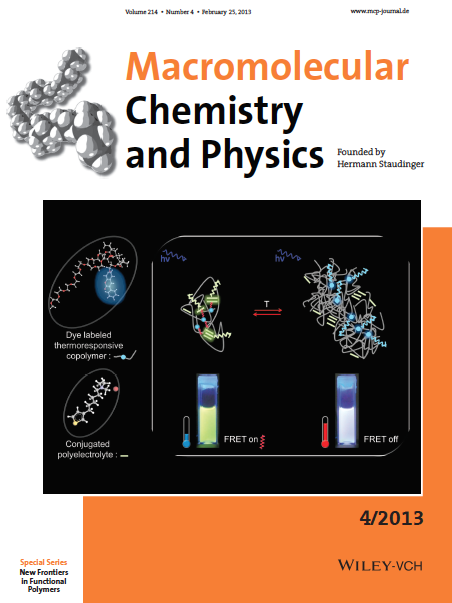 Aqueous mixtures of a coumarin-labeled non-ionic thermoresponsive copolymer and a cationic polythiophene exhibit marked changes in their fluorescence properties upon heating. At room temperature, emission from the label is significantly quenched due to energy transfer to the conjugated polyelectrolyte. Heating the mixture reduces the energy-transfer efficiency markedly, resulting in a clearly visible change of the emission color. Although the two macromolecules associate strongly at room temperature, the number of interacting sites is largely reduced upon the phase transition. Crucially, the intermolecular association does not suppress the responsiveness of the smart polymer, meaning that this concept should be applicable to chemo- or bioresponsive polymers with optical read-out, for example, as a sensor device. A non-ionic dye-labeled thermoresponsive polymer forms mixed aggregates with a cationic conjugated polyelectrolyte in aqueous solutions at room temperature. The interactions between the two macromolecules are temperature regulated, visualized as a distinct fluorescent response resulting from the marked change in energy-transfer efficiency. This scheme shall be applicable to biochemical sensors due to the well-resolved optical visualization of the stimuli-sensitive macromolecular association.
Aqueous mixtures of a coumarin-labeled non-ionic thermoresponsive copolymer and a cationic polythiophene exhibit marked changes in their fluorescence properties upon heating. At room temperature, emission from the label is significantly quenched due to energy transfer to the conjugated polyelectrolyte. Heating the mixture reduces the energy-transfer efficiency markedly, resulting in a clearly visible change of the emission color. Although the two macromolecules associate strongly at room temperature, the number of interacting sites is largely reduced upon the phase transition. Crucially, the intermolecular association does not suppress the responsiveness of the smart polymer, meaning that this concept should be applicable to chemo- or bioresponsive polymers with optical read-out, for example, as a sensor device. A non-ionic dye-labeled thermoresponsive polymer forms mixed aggregates with a cationic conjugated polyelectrolyte in aqueous solutions at room temperature. The interactions between the two macromolecules are temperature regulated, visualized as a distinct fluorescent response resulting from the marked change in energy-transfer efficiency. This scheme shall be applicable to biochemical sensors due to the well-resolved optical visualization of the stimuli-sensitive macromolecular association.